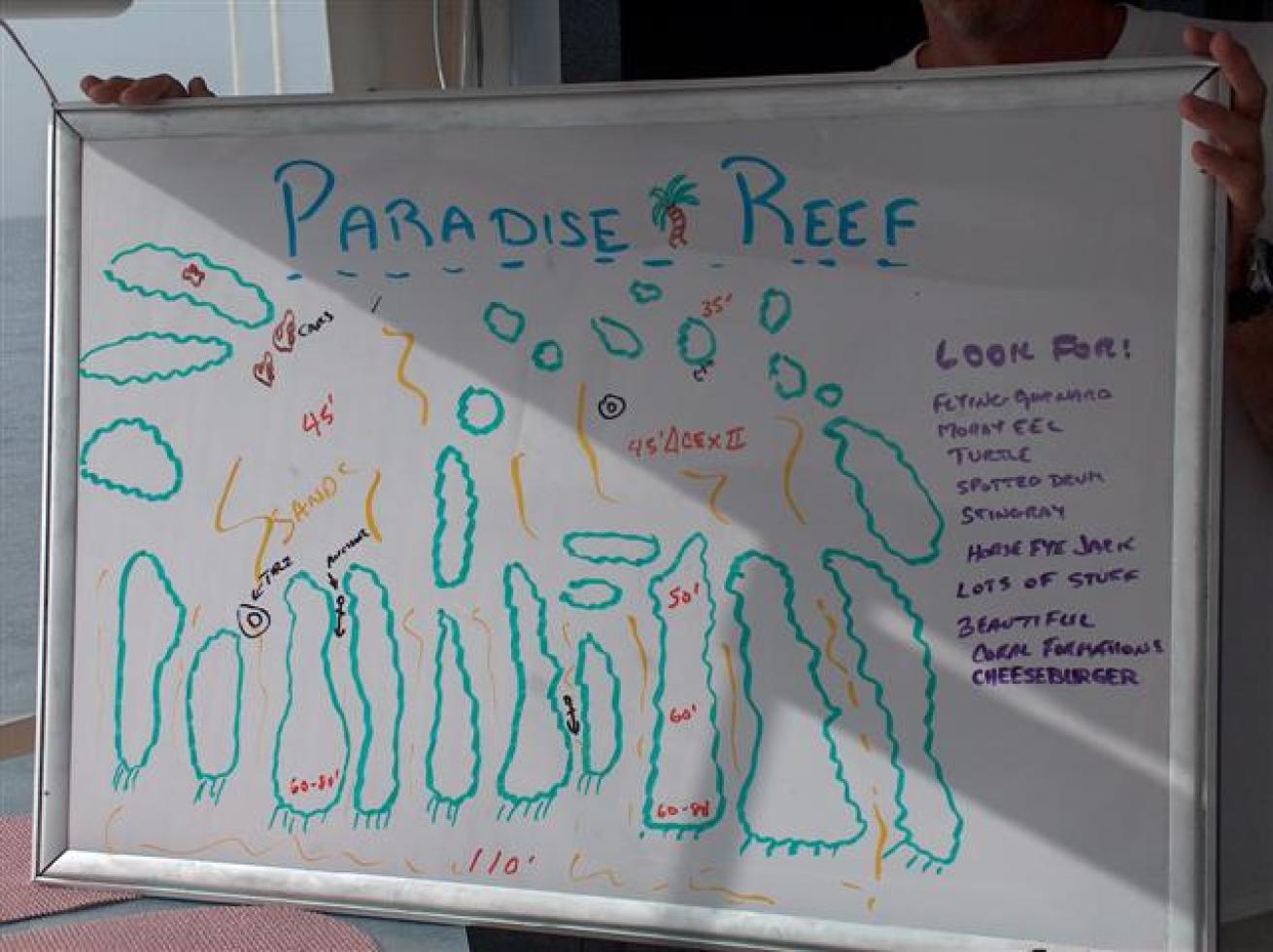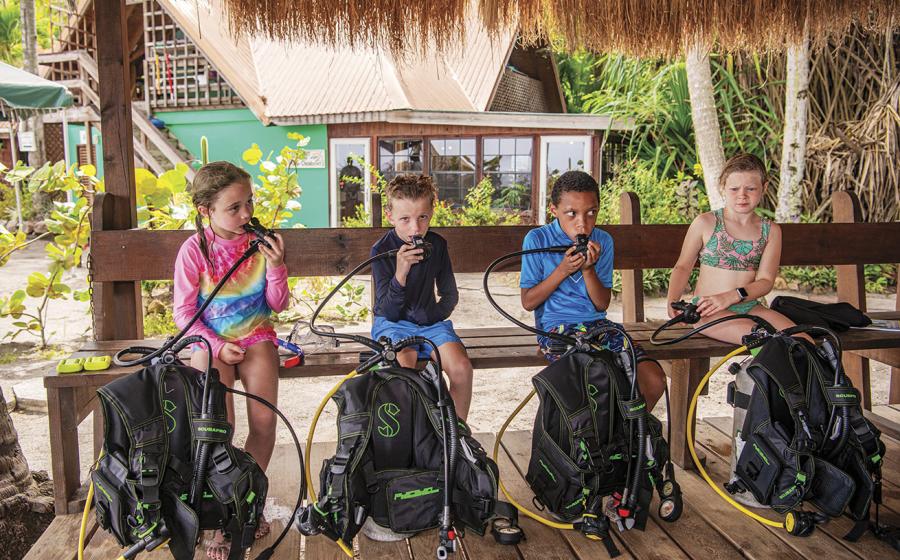Aboard Caribbean Explorer II in Netherland Antilles
CEXII.JPG
Our SCUBA trip to the Netherland Antilles
My wife, Ann, and I enjoy SCUBA diving. I have been certified since 1971 and she since 1994. We have taken many wonderful trips, primarily to the Caribbean. They have been about evenly split between land-based and live-aboard dive boats.
Our last trip was in August 2006 on the 120' live-aboard, Caribbean Explorer II. We flew to St. Maarten from Miami. The boat then cruised south for a week to our end point at St. Kitts. A taxi/minivan picked us and a few other divers up and delivered us to and from the dock and handled all the luggage nicely.
The boat has nine double cabins and usually has seven crewmembers, but in this case we only had ten divers and five crew. We had the same Captain, Jean-Francois Chabot, on this trip as we had on a previous trip at Turks & Caicos with the same charter company.
The weather was excellent the whole time with only one light rain shower, even though this was hurricane season. You get the best rates then, and the weather is usually the best also. However many of the larger sea life, like whales, whale sharks, and manta rays are less likely then as opposed to early spring.
These trips are all inclusive. Our typical day is awake for coffee on deck and breakfast to order in the dining lounge. Then dive twice before lunch, which may be hot or cold, dive twice more before dinner, and once more after dinner for a night dive if desired. In between dives we lounge on the sun deck and read or play cards. The bar is open whenever you want... except you can't dive if you drink.
After boarding at 3PM on Saturday, and all passengers being aboard, we left St. Maarten harbor for a nice cruise to our first stop at Saba. The next morning we awoke to a beautiful quiet sea and dove four dives during the day, starting with a check out dive at Customs Reef which sits below the old customs house which is up a long path on the steep mountainside. The most spectacular dive site was at Diamond Rock, see photo. Depths ranged from 50-100' and visibility was usually over 60'.
Monday we were diving additional sites, spotting some turtles and sharks at the Pinnacle and at Ladder Labyrinth, where we saw a Hawksbill turtle, 5' reef shark, pair of French angelfish, four eyed butterfly, flamingo tongue snails, Petersen shrimp, and arrowhead crab. Of course on every dive we loved all the usual tropical fish like various angelfish, tang, squirrelfish, grunt, and moray eels. At night we usually had a large group of tarpon rolling at the stern, attracted by stern floodlights. Underwater is truly an amazing world of its own.
Tuesday we were still diving in the morning, at Tedron and Tent Walls. In the afternoon we took a land tour of Saba. It is a very up and down island, with only one port, with narrow, hand laid concrete roads between the various towns. It has a population of about 1350 in 5 sq. mi. Various hiking trails cross the island and connect to peaks at 1300'. There is even the Saba University School of Medicine, a teaching hospital where many Americans come to become doctors. We stopped at various shops for gifts to take home. Our driver let us off at a trailhead and we hiked a short trail down to the road below through beautiful jungle garden.
Our next stop after an overnight cruise was at St. Eustatius, now known commonly as Statia, which was discovered by Columbus in 1493. The island has a marine sanctuary and requires you have a park ranger dive with your boat. While relaxing after our first dive, a Dutch Navy destroyer came up in support of a Coast Guard landing party to ensure we weren't carrying any contraband (drugs). It was exciting with two helicopters swooping overhead.
Here I did five dives including my only night dive, seeing French angels, arrow crabs, long snout butterfyfish, Bermuda chub, stingrays, pufferfish, and large barrel sponges. At the Barracuda reef site, my dive log noted beautiful coral gardens with 10' ridges, large barrel sponge, sea fans, gorgonians, and lots of lobster in cracks, crevices, and ledges. Also large rock hinds, cleaning stations, porcupine puffer, squirrelfish, red eye, French grunt, and potted moray. Some passengers opted for another land tour but I was diving.
On Thursday we arrived in St. Kitts. We dove at Anchors Away and Paradise Reef where there was beautiful large coral rising above deep canyons. Ann spotted vertical juvenile trunkfish hiding amongst fern and a turtle swimming to surface for air. The next morning we dove at two wreck sites, but it was in a bay and visibility was poor.
Then we docked in the capital port of Basseterre. We took a land tour and we saw a lovely garden plantation where they make batik fabrics, wild vervet monkeys, and the Brimstone Hill Fortress, constructed over a hundred year period by the British using slave labor starting in the 1690's. After our tour we went to the Marriott, a beautiful resort and recommended if you can afford it for an overnight.
The liked Saba the best for its friendly people and amazing scenery. There was nothing to say we liked least except having to go back home. The dive boat cost was $995pp plus tips (10%) and the airfare was $521 pp. Add in a few land tours, souvenirs, and incidentals and the total was about $4000 for the two of us. Note the prices were off-season and you should expect about +30% in the Jan-Mar high season. We highly recommend the trip to all SCUBA divers and we hope to go back.
Our SCUBA trip to the Netherland Antilles
My wife, Ann, and I enjoy SCUBA diving. I have been certified since 1971 and she since 1994. We have taken many wonderful trips, primarily to the Caribbean. They have been about evenly split between land-based and live-aboard dive boats.
Our last trip was in August 2006 on the 120' live-aboard, Caribbean Explorer II. We flew to St. Maarten from Miami. The boat then cruised south for a week to our end point at St. Kitts. A taxi/minivan picked us and a few other divers up and delivered us to and from the dock and handled all the luggage nicely.
The boat has nine double cabins and usually has seven crewmembers, but in this case we only had ten divers and five crew. We had the same Captain, Jean-Francois Chabot, on this trip as we had on a previous trip at Turks & Caicos with the same charter company.
The weather was excellent the whole time with only one light rain shower, even though this was hurricane season. You get the best rates then, and the weather is usually the best also. However many of the larger sea life, like whales, whale sharks, and manta rays are less likely then as opposed to early spring.
These trips are all inclusive. Our typical day is awake for coffee on deck and breakfast to order in the dining lounge. Then dive twice before lunch, which may be hot or cold, dive twice more before dinner, and once more after dinner for a night dive if desired. In between dives we lounge on the sun deck and read or play cards. The bar is open whenever you want... except you can't dive if you drink.
After boarding at 3PM on Saturday, and all passengers being aboard, we left St. Maarten harbor for a nice cruise to our first stop at Saba. The next morning we awoke to a beautiful quiet sea and dove four dives during the day, starting with a check out dive at Customs Reef which sits below the old customs house which is up a long path on the steep mountainside. The most spectacular dive site was at Diamond Rock, see photo. Depths ranged from 50-100' and visibility was usually over 60'.
Monday we were diving additional sites, spotting some turtles and sharks at the Pinnacle and at Ladder Labyrinth, where we saw a Hawksbill turtle, 5' reef shark, pair of French angelfish, four eyed butterfly, flamingo tongue snails, Petersen shrimp, and arrowhead crab. Of course on every dive we loved all the usual tropical fish like various angelfish, tang, squirrelfish, grunt, and moray eels. At night we usually had a large group of tarpon rolling at the stern, attracted by stern floodlights. Underwater is truly an amazing world of its own.
Tuesday we were still diving in the morning, at Tedron and Tent Walls. In the afternoon we took a land tour of Saba. It is a very up and down island, with only one port, with narrow, hand laid concrete roads between the various towns. It has a population of about 1350 in 5 sq. mi. Various hiking trails cross the island and connect to peaks at 1300'. There is even the Saba University School of Medicine, a teaching hospital where many Americans come to become doctors. We stopped at various shops for gifts to take home. Our driver let us off at a trailhead and we hiked a short trail down to the road below through beautiful jungle garden.
Our next stop after an overnight cruise was at St. Eustatius, now known commonly as Statia, which was discovered by Columbus in 1493. The island has a marine sanctuary and requires you have a park ranger dive with your boat. While relaxing after our first dive, a Dutch Navy destroyer came up in support of a Coast Guard landing party to ensure we weren't carrying any contraband (drugs). It was exciting with two helicopters swooping overhead.
Here I did five dives including my only night dive, seeing French angels, arrow crabs, long snout butterfyfish, Bermuda chub, stingrays, pufferfish, and large barrel sponges. At the Barracuda reef site, my dive log noted beautiful coral gardens with 10' ridges, large barrel sponge, sea fans, gorgonians, and lots of lobster in cracks, crevices, and ledges. Also large rock hinds, cleaning stations, porcupine puffer, squirrelfish, red eye, French grunt, and potted moray. Some passengers opted for another land tour but I was diving.
On Thursday we arrived in St. Kitts. We dove at Anchors Away and Paradise Reef where there was beautiful large coral rising above deep canyons. Ann spotted vertical juvenile trunkfish hiding amongst fern and a turtle swimming to surface for air. The next morning we dove at two wreck sites, but it was in a bay and visibility was poor.
Then we docked in the capital port of Basseterre. We took a land tour and we saw a lovely garden plantation where they make batik fabrics, wild vervet monkeys, and the Brimstone Hill Fortress, constructed over a hundred year period by the British using slave labor starting in the 1690's. After our tour we went to the Marriott, a beautiful resort and recommended if you can afford it for an overnight.
The liked Saba the best for its friendly people and amazing scenery. There was nothing to say we liked least except having to go back home. The dive boat cost was $995pp plus tips (10%) and the airfare was $521 pp. Add in a few land tours, souvenirs, and incidentals and the total was about $4000 for the two of us. Note the prices were off-season and you should expect about +30% in the Jan-Mar high season. We highly recommend the trip to all SCUBA divers and we hope to go back.







